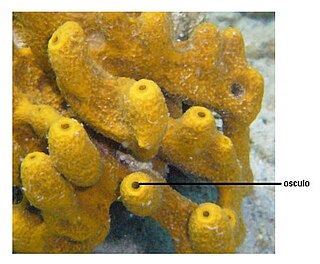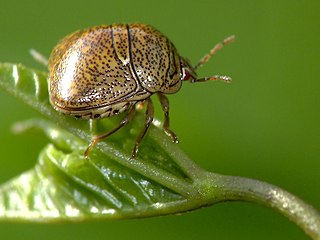
The osculum is an excretory structure in the living sponge, a large opening to the outside through which the current of water exits after passing through the spongocoel. Wastes diffuse into the water and the water is pumped through the osculum carrying away with it the sponge's wastes. Sponges pump large volumes of water: typically a volume of water equal to the sponge's body size is pumped every five seconds. The size of the osculum is regulated by contractile myocytes. Its size, in turn, is one of the factors which determines the amount of water flowing through the sponge. It can be closed completely in response to excess silt in the water.
The crumb-of-bread sponge is a species of sea sponge in the class Demospongiae.
Borojevia aspina is a species of calcareous sponge from Brazil. The species name refers to the lack of spines in the apical actine.
Arturia canariensis, commonly known as the yellow calcareous sponge, is a species of sponge in the family Clathrinidae. It is found in shallow seas in the Canary Islands, Cape Verde, the Adriatic Sea and the Caribbean Sea. The specific epithet "canariensis" was given to this species because it was first described from Lanzarote in the Canary Islands.
Ascandra contorta is a species of calcareous sponge belonging to the family Clathrinidae.
The red encrusting sponge is a species of sea sponge. It is known only from the South African coast, on both sides of the Cape Peninsula. It is endemic to this region.
The brain sponge is a species of marine demosponge in the family Isodictyidae. This sponge is known from the west coast of South Africa to Port Elizabeth. It is endemic to this region.

Plataspidae are a family of shield bugs native to the Old World. They are a family of hemipteran insects of the suborder Heteroptera.
Mycale grandis, the orange keyhole sponge, is a species of marine demosponge in the family Mycalidae. Mycale is a large genus and this species is placed in the subgenus Mycale making its full name, Mycale (Mycale) grandis.
Ophlitaspongia papilla is a species of demosponge belonging to the family Microcionidae. It is found along north-eastern Atlantic coastlines. This is a red sponge which forms thin, smooth encrusting patches, up to 5 cm across, with regularly spaced oscula.
Neofibularia nolitangere, commonly known as the touch-me-not sponge, is a species of sea sponge in the family Biemnidae. It is found in shallow waters in the Western Atlantic Ocean and the Caribbean Sea.
Aaptos papillata is a species of sea sponge belonging to the family Suberitidae. This species was first described in 1880. It is native to the northeastern Atlantic Ocean, the English Channel and the Mediterranean Sea.

Haliclona caerulea is a species of marine sponge in the family Chalinidae. It is an encrusting tubular sponge that grows anchored on rocky surfaces of coral reefs.
Cliona orientalis is a species of demosponge in the family Clionaidae. It occurs in the Indo-Pacific region and is a bioeroding species, with various specialisations for living on and inside calcareous substrates such as massive corals and molluscs.
Corticium candelabrum is a species of sponge in the order Homosclerophorida. It is native to the eastern Atlantic Ocean and the Mediterranean Sea where it inhabits the shallow sublittoral zone. The type locality is the Adriatic Sea.
Biemna variantia is a species of sponge in the family Biemnidae. It is native to the northwestern Atlantic Ocean, the northeastern Atlantic Ocean, the North Sea and the Mediterranean Sea. This species was first described in 1858 by the British naturalist James Scott Bowerbank, who gave it the name Halichondria variantia. It was later moved to the genus Biemna and is the type species of the genus. The type locality is Tenby, Wales.
Hymeniacidon kitchingi is a species of sponge in the class Demospongiae. It is found in shallow waters in the northeastern Atlantic Ocean. This species was first described in 1935 by the British zoologist Maurice Burton. He placed it in a new genus because of its unusual spicules, and named it Rhaphidostyla kitchingi, in honour of Dr J. A. Kitching, who had collected the original specimen. It was later transferred to the genus Hymeniacidon.

Aplysina aerophoba is a species of sponge in the family Aplysinidae. It is a yellow, tube-forming or encrusting sponge and is native to the eastern Atlantic Ocean and the Mediterranean Sea; the type locality is the Adriatic Sea.

Spirastrella coccinea is a species of marine sponge in the family Spirastrellidae. It is found in the tropical western Atlantic Ocean, the Caribbean Sea, and the Gulf of Mexico.

Monanchora arbuscula is a species of marine demosponge in the family Crambeidae.





